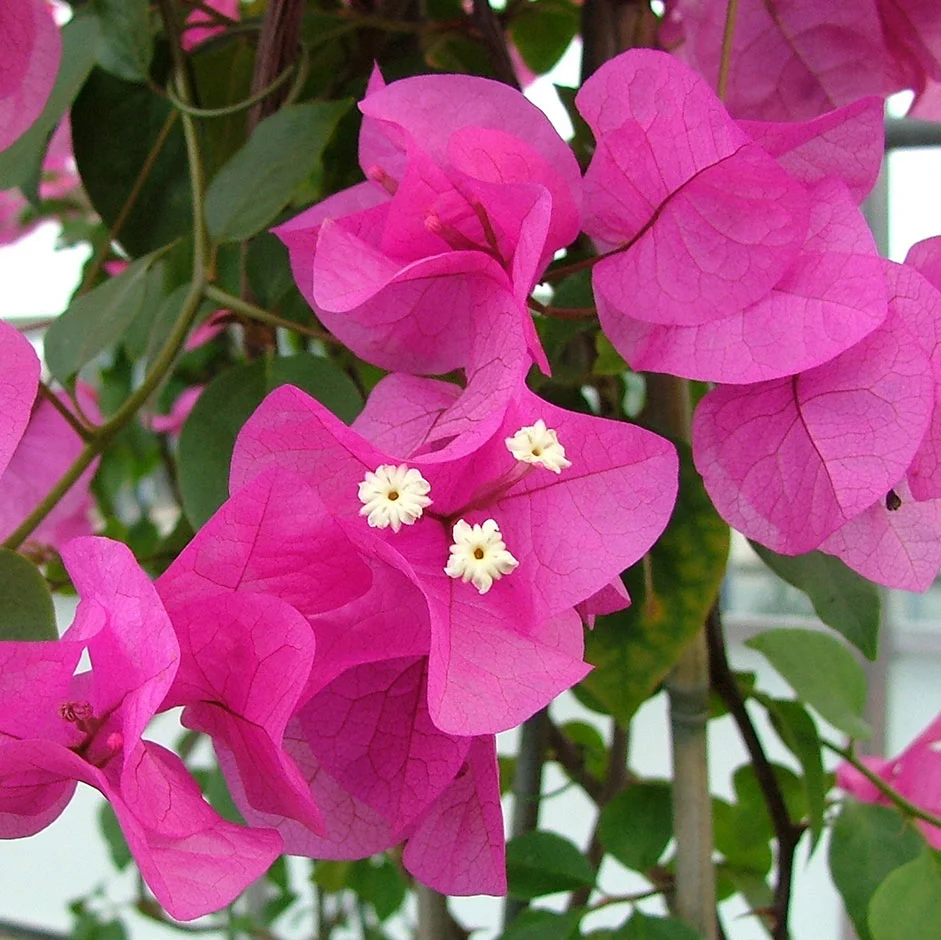Bougainvillea
Vibrantly coloured bracts of Bougainvillea brighten warm greenhouses and conservatory borders during the summer. These tropical climbers are suitable for large containers placed in the garden during summer but must be kept frost-free in winter. By following the tips below you will be rewarded a stunning display

Quick facts
Botanical name Bougainvillea
Group Evergreen climber
Flowering time Summer to autumn
Planting time Spring
Height and spread 4-8m (13-26ft) height and 1-1.5m (3-5ft) spread
Aspect Bright light with protection in mid-summer
Hardiness Half hardy (required heated glasshouse; may be grown outside in summer)
Difficulty Moderate
Cultivation notes
Bougainvilleas need a bright sunny position, but protection from direct sunlight under glass and a minimum night temperature of 10°C (50°F). As large climbers they can be planted directly into a conservatory border or grown in large containers. These can be placed in the garden in summer but must be kept
Spring and Summer
- Increase water in February-March as the increasing light levels and temperatures stimulate growth
- Maintain high
humidity buds - Re-pot if necessary in early spring, using loam-based compost such as John Innes 3
- If containerised, place outdoors in full sun, ideally 18-21°C (65-70°F) at night, a few degrees warmer by day
- Once plants are growing strongly around mid-April, water freely and feed weekly with a high nitrogen liquid feed
- When bracts show colour, change to a high potassium feed and move plants to cooler conditions (if possible to 10°C (50°F)) with good
ventilation - When bracts have dropped resume high nitrogen feed to encourage a second flush of bracts
Autumn and Winter
- Once flowering ends, usually in September, reduce frequency of watering, allowing the plant to become drier between watering and stop feeding
- From November, water occasionally but thoroughly
- Maintain a minimum night temperature of 10°C (50°F). Bougainvillea can be stored above freezing provided the compost is kept relatively dry but they will drop leaves
Pruning and training
Bougainvilleas require a trellis or pillar for support and can be trained as a standard and spur-pruned to restrict size. They flower on the current seasons growth so pruning in late winter or early spring, just before growth begins.
- Early in the season, bend and tie in young strong-growing laterals to check the vigour and stimulate bract formation
- After the bracts have fallen cut this long growth back by half to encourage a second flush of bracts in the late summer
- Plants should respond to hard pruning but old plants are better replaced
Propagation
Propagate by semi-ripe cuttings taken with a heel in summer. Cuttings should root in 4-6 weeks or quicker with bottom heat of 15°C (50°F). Alternatively, take hardwood cuttings in deep pots in winter with bottom heat of 3-6°C (5-10°F) above the air temperature to encourage rooting. These late season cuttings may take three months to root.
Layering in late winter and early spring is usually more effective and new plants will flower in 2-3 years.
Cultivar Selection
Only two species and one hybrid of Bougainvillea are generally in cultivation in this country and B. glabra and the hybrid B. × buttiana (B. glabra, B.peruviana) are best for containers as they flower when young.
Bougainvillea × buttiana ‘Poulton’s Special’ AGM: magenta-rose bracts [B. × buttiana ‘Poulton’s Special’ AGM]
B. × buttiana’Raspberry Ice’: Cream margins to the leaves and cerise bracts
B. ‘African Sunset’: Large bright orange bracts
Links
Problems
They are generally disease free but may be attacked by whitefly, mealybug, aphid and red spider mite.
Avoid leaf drop in winter by maintaining a minimum night temperature of 10°C (50°F) with the day temperature a few degrees higher.
Non-flowering – prune established plants in May and expose to cooler temperatures to stimulate flowering.
Get involved
The Royal Horticultural Society is the UK’s leading gardening charity. We aim to enrich everyone’s life through plants, and make the UK a greener and more beautiful place.